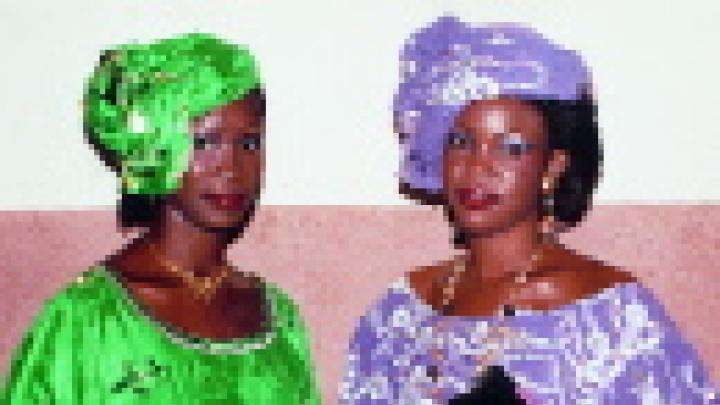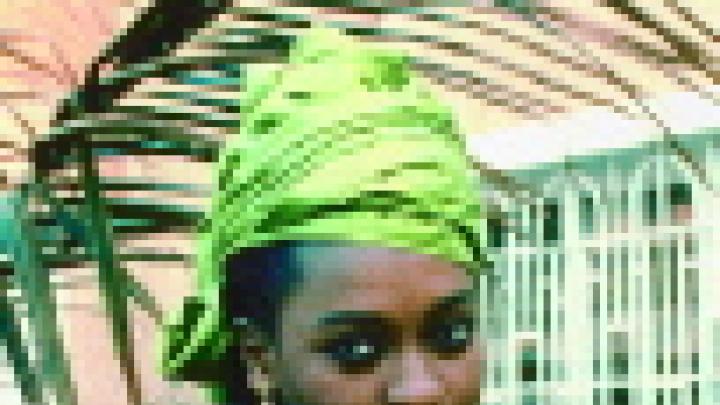The ironies abound: women who can scarcely put food on the table cut elegant figures on city streets. Families who live in rundown concrete houses throw lavish feasts, or exchange gifts of expensive cloth and gold at weddings. This is Dakar, Senegal, in the early 1990s. The economy has imploded: many men, such as the former public servants of a collapsed state bureaucracy--the legacy of French colonialism--are unemployed, yet their wives have become entrepreneurs, designing modish garments for more elite female clients. Although Senegalese women traditionally have not worked outside the home, now they are driving hard bargains in Dakar's thriving international cloth trade.
Such anomalies struck anthropologist Hudita Mustafa, Ph.D. '98, when she arrived in Dakar in 1991, and they became the focus of her doctoral dissertation. "There was wide-ranging instability," she says. "To get international aid, the government had to slash its budget, lopping off subsidies to industry and making big cuts in its own civil-service bureaucracy. All the major social institutions broke down. I wondered, how was it that fashion--not a basic need--could expand in these conditions?" Eventually Mustafa explained this riddle as "the paradox of crisis and creativity." As Senegal has forged a postcolonial identity and wrestled with a painful shift in gender roles, fashion has answered economic needs and crystallized many social dynamics.
A fellow of the Rockefeller African Humanities Institute at the DuBois Institute for Afro-American Studies, Mustafa is revising her thesis into a book, "Sartorial Modernities," that expands her exploration of society and fashion in Senegal. For the Senegalese women, the display of beauty and prosperity became a coping mechanism: women not only saved face, but tapped into a life-affirming well of creativity.
This outcome has roots not only in the recent crises, but also in Dakar's long cosmopolitan history, which accepts and blends European, Islamic, and African influences. Yet it also draws much of its energy from the emphasis West African societies have long placed on intertwined notions of beauty and morality. "Senegalese women are noted for their grace, self-care, and elegance. They are arrestingly beautiful--tall and dark-skinned," Mustafa says. "The question of the relationship between exterior, physical beauty and inner, moral beauty comes up all the time in ordinary conversation." An essay she contributed to The Art of African Fashion in 1998 states, "Old proverbs warn against admiring beauty at the expense of goodness, yet, in practice, beauty is seen as a kind of goodness." Thus inner, moral beauty is seen to express itself in both behavior and appearance, and becomes the nexus of the country's deeply ingrained code of conduct, which centers on courtesy, hospitality, and generosity.
In everyday life, women, in particular, focus on attending to people, and sacrifice heavily to give gifts in important social rituals like weddings and newborn-naming ceremonies. Intense rivalries have grown up around traditional social functions; families strive to outdo one another, for example, in outwardly hospitable displays of gift-giving and feasting. Regarding appearance, women pull out all stops--especially the elegant, sensual, and corpulent women called dirriankhes (de-ree-ahn-keys), the icons of Dakar's vibrant popular fashion culture. "At weddings and naming days," Mustafa writes, "everyone watches the neighborhood fashion queens for signs of the latest cloth from Jeddah or the newest embroidery thread."
Dirriankhe, originally used to describe socially elite women, now applies to any woman who strives to be well-dressed. The fact that Senegalese both ridicule and imitate dirriankhes--men and women mock them for neglecting basic needs to afford their finery, yet women of lesser means scramble to knock off their high-style outfits, using cheap material--signaled to Mustafa that fashion embodied a skein of conflicting meanings and hierarchies.
The frenetic quest to outdress each other has spawned an industry increasingly ruled by women--in particular, women of the Mouride Brotherhood, an Islamic Sufi group that is rapidly replacing the old Francophone elite at the top of Senegalese society. Since the 1980s, women have dominated the wholesale cloth trade. Traders travel to Europe and the Middle East to buy luxury fabrics and contract with Hong Kong manufacturers to produce imitations of luxury cloth for the low-income market. The new prosperity and power have exacted a price, however. "Women are facing criticism and vocal resentment," Mustafa says. "On the street, you hear tailors and other men shouting about being exploited by women in business dealings. Husbands complain that their wives are out and about too much in public. Yet some of these same men gave their wives the seed money to start small businesses that they considered beneath their own status."
Across class and gender categories and also within them, Mustafa says, "fashion is the way social rivalry is expressed" in Senegal. Her observations, she believes, shed light on how cultures and economies are linked--and on the strategies people use to cope with social and financial upheaval. "Since a lot of the Third World is in crisis," she says, "it is important to look at how people engage with such profound change."









